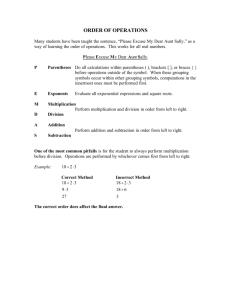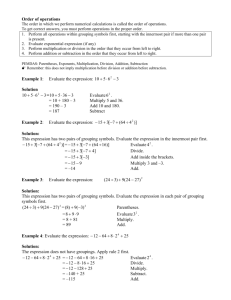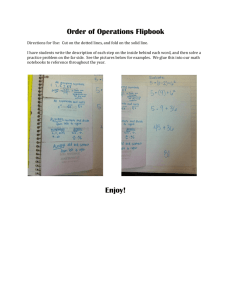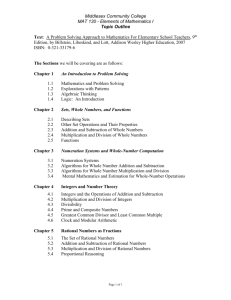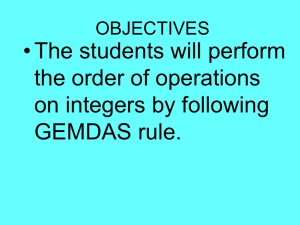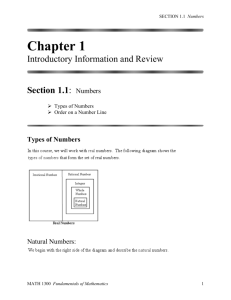Order of Operations - Section 1.5
advertisement
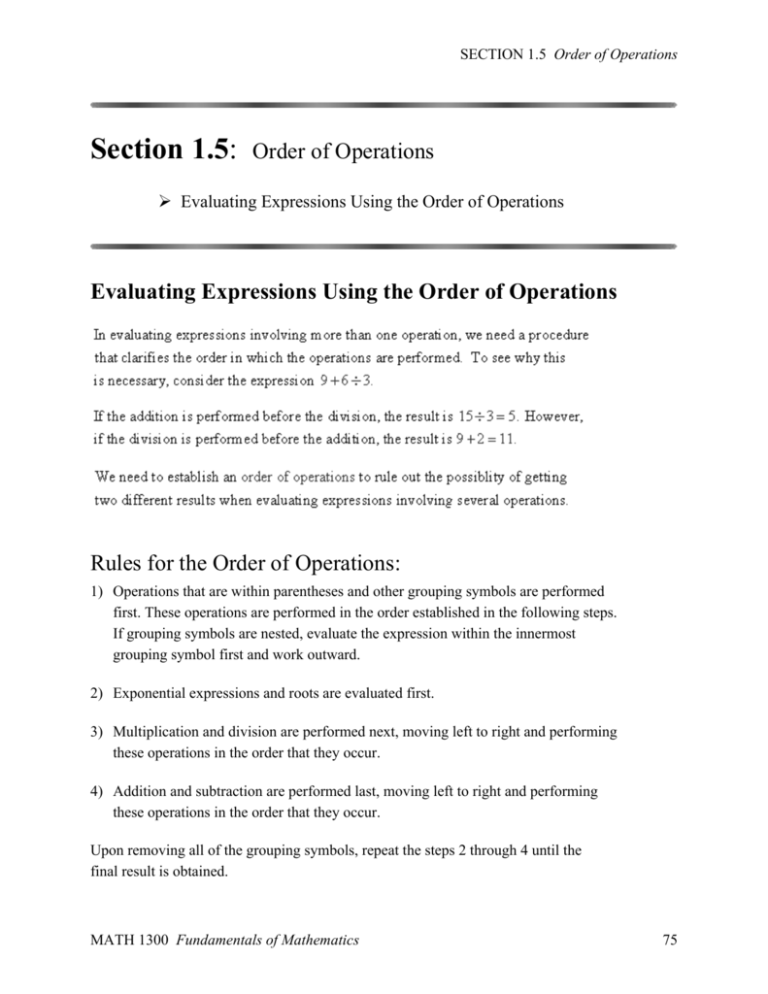
SECTION 1.5 Order of Operations Section 1.5: Order of Operations Evaluating Expressions Using the Order of Operations Evaluating Expressions Using the Order of Operations Rules for the Order of Operations: 1) Operations that are within parentheses and other grouping symbols are performed first. These operations are performed in the order established in the following steps. If grouping symbols are nested, evaluate the expression within the innermost grouping symbol first and work outward. 2) Exponential expressions and roots are evaluated first. 3) Multiplication and division are performed next, moving left to right and performing these operations in the order that they occur. 4) Addition and subtraction are performed last, moving left to right and performing these operations in the order that they occur. Upon removing all of the grouping symbols, repeat the steps 2 through 4 until the final result is obtained. MATH 1300 Fundamentals of Mathematics 75 CHAPTER 1 Introductory Information and Review Example: Solution: Example: Solution: Additional Example 1: 76 University of Houston Department of Mathematics SECTION 1.5 Order of Operations Solution: Additional Example 2: Solution: Additional Example 3: Solution: MATH 1300 Fundamentals of Mathematics 77 CHAPTER 1 Introductory Information and Review Additional Example 4: Solution: Additional Example 5: Solution: 78 University of Houston Department of Mathematics Exercise Set 1.5: Order of Operations Answer the following. 1. (b) If choosing between multiplication and division, which operation should come first? (Circle the correct answer.) Multiplication Division Whichever appears first (c) If choosing between addition and subtraction, which operation should come first? (Circle the correct answer.) Addition Subtraction Whichever appears first When performing order of operations, which of the following are to be viewed as if they were enclosed in parentheses? (Circle all that apply.) Absolute value bars Radical symbols Fraction bars 4. 5. 6. (b) 2 (7 5) (d) 2 7( 5) (f) 2(7) 5 7 8. (a) 6 2 (4) (b) 6 2 (4) (c) 6 2( 4) (e) 2 (6) 4 (d) (6 2)( 4) (f) 2 4(6 2) (a) 3 4 5 (c) 3 4 5 (e) 3 4 5 (a) 10 6 7 (c) 10 6(7) (e) 7 10 6 9. 2 1 1 5 3 4 2 1 1 (d) 5 3 4 2 1 1 5 3 4 2 11 1 (c) 5 3 4 4 (a) (b) 35 1 26 3 5 (c) 1 2 6 35 1 26 3 5 (d) 1 2 6 10. (a) 11. (a) 5 4 7 (b) (b) 1 7 2 2 (c) 5 1 4 7 (d) 7 4 1 5 (e) 52 12 (f) 5 12 (b) 23 3 12. (a) 2 32 2 2 (c) 2 3(1 4) (d) ( 2 3) 1 4 (e) 2 2 32 (f) 3 2 32 (b) 20 2 10 13. (a) 20 2(10) (c) 20 10 (2) 10 5 Evaluate the following. 3. (a) 2 7 5 (c) 2 (7) 5 (e) 2(7 ( 5)) In the abbreviation PEMDAS used for order of operations, (a) State what each letter stands for: P: ____________________ E: ____________________ M: ____________________ D: ____________________ A: ____________________ S: ____________________ 2. 7. (b) (3 4) 5 (d) (3 4) 5 (f) 3 (4 5) (b) (10 6) 7 (d) 10 (6 7) (f) 7 (10 6) (a) 37 (b) 73 (c) 3 7 (d) 7 3 (a) 25 (b) 2 5 (c) 25 (d) 2 5 MATH 1300 Fundamentals of Mathematics 14. (a) 24 4(2) (b) (24 4) 2 (c) 24( 2) 4 2( 2) 15. (a) 102 5 2 10 5 2 2 (b) (c) 2 10 2 5 5 2 16. (a) (3 9) 3 4 (c) 3 9 3 4 3 17. (a) 3 18. (a) 5 1 6 2 3 (b) 3 (9 3) 4 (b) 3 (b) 5 1 1 1 6 2 3 (c) 3 (c) 5 1 1 1 6 2 3 1 1 79 Exercise Set 1.5: Order of Operations 19. 7 41 51 20. 8 31 7 1 35. 81 2 4 32 2 36. 64 52 4 23 4 21. 7 5 2 3 2 22. 3 23 3 2 4 23. 37. 42 121 52 4 3 38. 144 52 2 62 12 3 1 1 3 2 3 4 39. 25 5 33 40. 26. 3 2 16 41. 4 1 30. 3 49 3 49 22 3 49 4 1 2 3 9 16 9 16 12 42. 28. 2 3 4 1 29. 2 3 4 1 32. 2 3 4 1 9 16 2 3 2 43. 4 1 31. 2 3 5 2 2 8 24 2 32 5 2 44. 2 8 2 4 2 5 32 32 7 33. 34. 80 9 16 12 16 27. 2 3 49 3 22 3 3 10 24. 5 10 3 25. 3 7 7 3 45. 12 2 3 3 2 4 3 15 1 5 12 6 3 4 2 2 1 5 2 25 46. 2 23 42 14 81 2 3 2 2 81 16 22 23 2 2 3 32 1 3 1 1 4 2 University of Houston Department of Mathematics Exercise Set 1.5: Order of Operations Evaluate the following expressions for the given values of the variables. r k for P 5, r 1, and k 7 . 48. x y y z for x 4, y 3, and z 8 . 49. b b 2 8c c2 for b 4 and c 2 . 50. b b 2 4ac 2a for a 1, b 3, and c 18 . 47. P MATH 1300 Fundamentals of Mathematics 81

